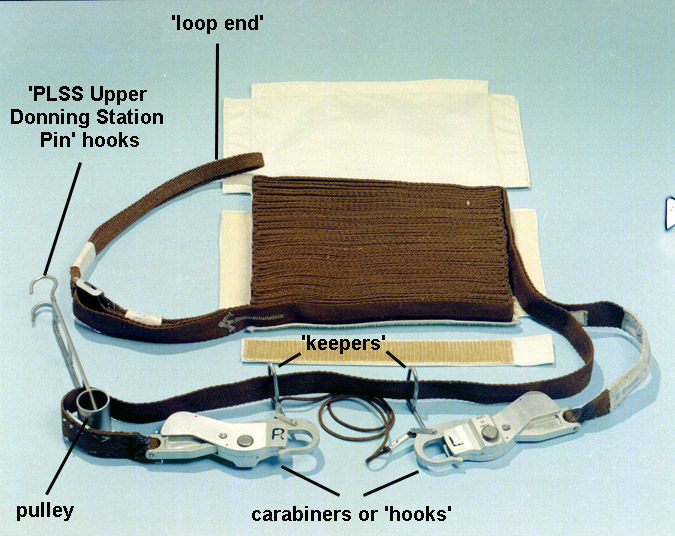
Lunar Equipment Conveyor (LEC)
Copyright © 2004 by Eric M. Jones.
All rights reserved.
Last revised 2 February 2015.

Armstrong - "(The LEC) was a piece of equipment that did not exist - was not planned - until we were someplace in the middle of our training cycle. And we were not confident about our ability to transfer articles to and from the cabin and the surface. I can't remember who devised this idea, but it was devised collectively by our EVA planning group. It was a jury-rig that we collectively devised."As mentioned on page 22 in Apollo Experience Report TN-D-6737, "During the Apollo 12 (LM-6) training, the crewmen requested that the lunar-equipment conveyor be changed to a single-strap design." This modified LEC was used on Apollos 12 through 15; although, beginning with Apollo 14, the astronauts sometimes carried equipment up and down the ladder by hand. The Apollo 16 and 17 crews flew with only a simple lanyard with which they raised and lowered the Equipment Transfer Bag with its cargo of relatively fragile cameras at the side of the porch, as Buzz had suggested. None of the Apollo 11-to-15 astronauts had a clear memory of the LEC attachment hardware that was used in the cabin.Aldrin - "It was needed. There wasn't another solution to the problem. Didn't it do the job reasonably well?"
Armstrong - "Yeah, it did."
Aldrin - "It wasn't very professional."
Armstrong - "It was a bit of a jury-rig, but it did the job."
Aldrin - "I guess one problem was that it tended to carry up dust? It didn't have a pulley, you just lifted at the top. Or did it have a pulley?" (see below)
Armstrong - "It was a flat nylon strap, as I remember..."
Aldrin - "Didn't it just go through the AOT guard, or did it have a pulley?"
Armstrong - "I don't remember. It may have been some kind of a cylinder with a hook."
Aldrin, from the 1969 Technical Debrief - "There are alternate ways of bringing things up, other than by the LEC. I think there is promise of being able to bring things up over the side (of the porch); straight up, versus making use of the LEC. We didn't have the opportunity to exercise those."

Prior to deployment, the LEC was stowed in nested cloth bags.
NASA photo S69-37994 ( 269k ) shows the LEC positioned on the parts of the inner bag, which will be assembled with Velcro fastenings.
NASA photo S69-37995 ( 242k ) shows the inner bag partially assembled.
NASA photo S69-37996 ( 257k ) shows the inner bag fully assembled.
NASA photo S69-37997 ( 248k ) shows the outer stowage bag containing two 'waist tethers', each with a small snap hook at one end and a larger snap hook at the other end. Note that the outer bag, itself, is equipped with a short strap and snap hook. The waist tethers were intended for use during an EVA transfer to the Command Module, had there been a problem with docking. For Apollo 11, the crew intended to attach one to the spare Hasselblad that Buzz was to place on the cabin floor just inside the hatch during the EVA so that the free end of the tether could be hooked to the porch handrail and the camera could be lowered into reach, as shown in a labelled detail from training photo S69-31114. A training photo from 10 July 1969 shows Buzz in the KC-135 aircraft attaching the large hook of what is presumably a waist tether to the base of the left porch rail, which suggests that there was a late decision to take the waist tether outside for attaachment to the porch rail, rather than leave it just inside the forward hatch attached to the spare Hasselblad. A labelled detail from AS11-40-5886, one of Neil images of Buzz descending the ladder, shows both the LEC and the waist tether. During the rest period, Neil used one of the waist tethers as a sling to hold his feet up.
NASA photo S69-37999 ( 253k ) shows the outer bag with a large snap hooks packed on either side, intended for attachment to the tiedown straps the astronauts had on their suits just below the RCU. There are three small snap hooks lying on top in the center part of the outer bag. The one farthest back is the outer-bag hook with its attached strap. The other two are each attached to a waist tether as seen in the previous photo.
NASA photo S69-37998 ( 283k ) shows the outer bag with the LEC hooks and pulley added. The inner bag is out of frame to the left.
NASA photo S69-38000 ( 312k ) shows the inner bag in place prior to closure of the outer bag.
[Training photo S69-32232 shows Neil operating the LEC while Buzz watches. During the mission, Buzz was always in the cabin during LEC operations.]